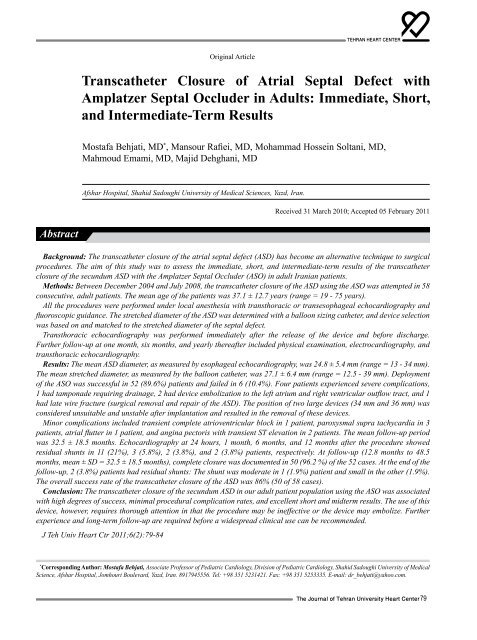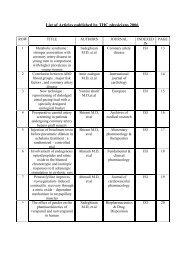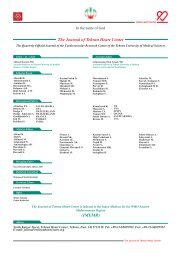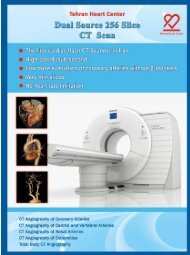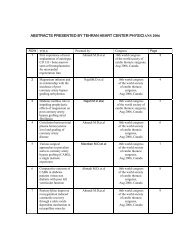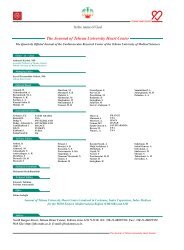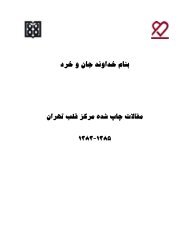Journal of Tehran University Heart Center
Journal of Tehran University Heart Center
Journal of Tehran University Heart Center
Create successful ePaper yourself
Turn your PDF publications into a flip-book with our unique Google optimized e-Paper software.
TEHRAN HEART CENTER<br />
Original Article<br />
Transcatheter Closure <strong>of</strong> Atrial Septal Defect with<br />
Amplatzer Septal Occluder in Adults: Immediate, Short,<br />
and Intermediate-Term Results<br />
Mostafa Behjati, MD * , Mansour Rafiei, MD, Mohammad Hossein Soltani, MD,<br />
Mahmoud Emami, MD, Majid Dehghani, MD<br />
Afshar Hospital, Shahid Sadoughi <strong>University</strong> <strong>of</strong> Medical Sciences, Yazd, Iran.<br />
Received 31 March 2010; Accepted 05 February 2011<br />
Abstract<br />
Background: The transcatheter closure <strong>of</strong> the atrial septal defect (ASD) has become an alternative technique to surgical<br />
procedures. The aim <strong>of</strong> this study was to assess the immediate, short, and intermediate-term results <strong>of</strong> the transcatheter<br />
closure <strong>of</strong> the secundum ASD with the Amplatzer Septal Occluder (ASO) in adult Iranian patients.<br />
Methods: Between December 2004 and July 2008, the transcatheter closure <strong>of</strong> the ASD using the ASO was attempted in 58<br />
consecutive, adult patients. The mean age <strong>of</strong> the patients was 37.1 ± 12.7 years (range = 19 - 75 years).<br />
All the procedures were performed under local anesthesia with transthoracic or transesophageal echocardiography and<br />
fluoroscopic guidance. The stretched diameter <strong>of</strong> the ASD was determined with a balloon sizing catheter, and device selection<br />
was based on and matched to the stretched diameter <strong>of</strong> the septal defect.<br />
Transthoracic echocardiography was performed immediately after the release <strong>of</strong> the device and before discharge.<br />
Further follow-up at one month, six months, and yearly thereafter included physical examination, electrocardiography, and<br />
transthoracic echocardiography.<br />
Results: The mean ASD diameter, as measured by esophageal echocardiography, was 24.8 ± 5.4 mm (range = 13 - 34 mm).<br />
The mean stretched diameter, as measured by the balloon catheter, was 27.1 ± 6.4 mm (range = 12.5 - 39 mm). Deployment<br />
<strong>of</strong> the ASO was successful in 52 (89.6%) patients and failed in 6 (10.4%). Four patients experienced severe complications,<br />
1 had tamponade requiring drainage, 2 had device embolization to the left atrium and right ventricular outflow tract, and 1<br />
had late wire fracture (surgical removal and repair <strong>of</strong> the ASD). The position <strong>of</strong> two large devices (34 mm and 36 mm) was<br />
considered unsuitable and unstable after implantation and resulted in the removal <strong>of</strong> these devices.<br />
Minor complications included transient complete atrioventricular block in 1 patient, paroxysmal supra tachycardia in 3<br />
patients, atrial flutter in 1 patient, and angina pectoris with transient ST elevation in 2 patients. The mean follow-up period<br />
was 32.5 ± 18.5 months. Echocardiography at 24 hours, 1 month, 6 months, and 12 months after the procedure showed<br />
residual shunts in 11 (21%), 3 (5.8%), 2 (3.8%), and 2 (3.8%) patients, respectively. At follow-up (12.8 months to 48.5<br />
months, mean ± SD = 32.5 ± 18.5 months), complete closure was documented in 50 (96.2 %) <strong>of</strong> the 52 cases. At the end <strong>of</strong> the<br />
follow-up, 2 (3.8%) patients had residual shunts: The shunt was moderate in 1 (1.9%) patient and small in the other (1.9%).<br />
The overall success rate <strong>of</strong> the transcatheter closure <strong>of</strong> the ASD was 86% (50 <strong>of</strong> 58 cases).<br />
Conclusion: The transcatheter closure <strong>of</strong> the secundum ASD in our adult patient population using the ASO was associated<br />
with high degrees <strong>of</strong> success, minimal procedural complication rates, and excellent short and midterm results. The use <strong>of</strong> this<br />
device, however, requires thorough attention in that the procedure may be ineffective or the device may embolize. Further<br />
experience and long-term follow-up are required before a widespread clinical use can be recommended.<br />
J Teh Univ <strong>Heart</strong> Ctr 2011;6(2):79-84<br />
*<br />
Corresponding Author: Mostafa Behjati, Associate Pr<strong>of</strong>essor <strong>of</strong> Pediatric Cardiology, Division <strong>of</strong> Pediatric Cardiology, Shahid Sadoughi <strong>University</strong> <strong>of</strong> Medical<br />
Science, Afshar Hospital, Jomhouri Boulevard, Yazd, Iran. 8917945556. Tel: +98 351 5231421. Fax: +98 351 5253335. E-mail: dr_behjati@yahoo.com.<br />
The <strong>Journal</strong> <strong>of</strong> <strong>Tehran</strong> <strong>University</strong> <strong>Heart</strong> <strong>Center</strong> 79


